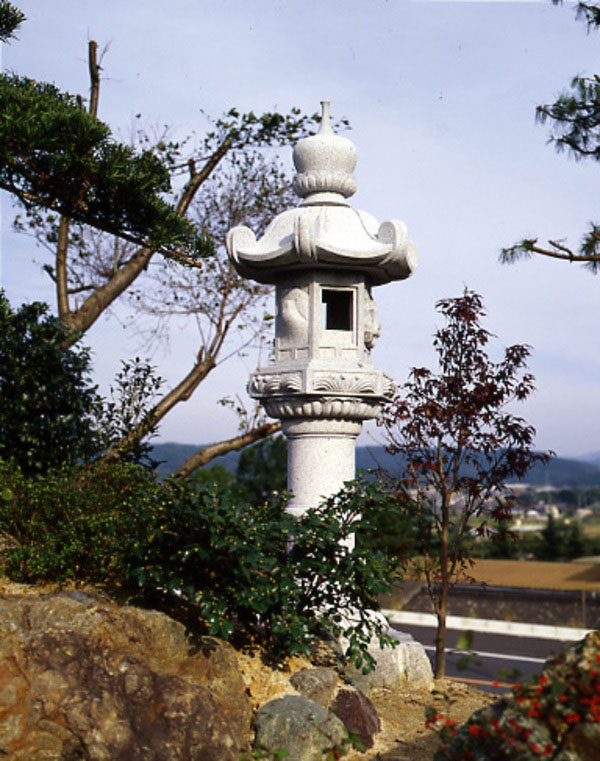
- Stonework
- Aichi
Okazaki stonemasonry Okazaki sekkohin
From master to apprentice, a 400 year tradition
of hand crafting stone to release its inner beauty
Description
What is Okazaki stonemasonry ?
Okazaki Stonemasonry, called Okazaki Sekkouhin in Japanese, are stone crafts and gem carvings produced in the area around the city of Okazaki in Aichi prefecture. They are made using traditional masonry skills that were found and developed in the late years of the Muromachi period (1336-1573). The original stone lantern form was established in the Azuchi Momoyama period (1573-1600) and the easy acquisition of fine quality Okazaki granite supported the development of the masonry industry. Makabe in Ibaraki prefecture, Aji in Kagawa prefecture, and Okazaki in Aichi prefecture are known as the three major stone production areas in Japan. Each area produces its own characteristic stone. The Makabe region has a large variety of stone types and a high production volume because of its abundant and good quality granite. The stone from Aji has a very attractive mottled pattern unique to the region, and it is categorized as a world class stone. Okazaki Stonemasonry has a long history, and one of its characteristics is the abundance of stone with distinctive marbling such as Okazaki granite. Moreover, its masonry skills and techniques have been developed to such an extent that it is known as the stone capital of Japan, and in 1979, Okazaki Stonemasonry was designated as a Japanese traditional craft.
History
During the Azuchi Momoyama period, Yoshimasa TANAKA (1548-1609), the lord of Okazaki castle, brought skilled stonemasons from Kawachi and Izumi to construct walls and moats in the castle town. The unique techniques were refined by the stonemasons that stayed in Okazaki, as they made further developments and established the current form of Okazaki stonemasonry. Okazaki region became a leading stonemasonry area with their abundance of high quality granites. In the early days, there were only a few dozen of masonry workshops, but by the golden age after World War II, the number of stone production workshops expanded to 350, and stonemasonry became Okazaki's major local industry. The Yahagi River was an efficient means of transport, and contributed to the development of the industry. After World War II, when the Japanese economy was rapidly growing, mechanization increased drastically, and this increased the efficiency of production. This surely affected the stone crafts as well. In addition, the development of the automobile industry led to the expansion of the stone craft marketplace and consequently, a masonry housing complex was established. Today, a vocational training school passes down the traditional techniques of Okazaki stonemasonry.
General Production Process
- 1. The gem The major products of Okazaki stonemasonry are stone lanterns consisted of six parts; the gem, the shade, the fire box, the central platform, the post, and the base platform. Each part is carved before being assembled. The basic lantern consists of these six parts, but there are also modified types such as the Oribe type stone lantern. The following describes the production process of the Oribe stone lantern, which is a lantern assembled with five pieces. It does not have a base platform, and the post is implanted directly in the ground. To make the gem shaped part which is the top part of the lantern, the core is shaped in the center on the bottom side of the stone. The diameter of the jewel is inked out with Chinese ink and is then roughly chipped and shaped using a hammer for chipping stones. The gem is finished with a bush hammer and a tataki hammer to make hammered patterns.
- 2. The shade (part 1) For the first step, the top side and bottom side are carved. After the center of the rough stone is determined, the stone is carved and a square is drawn with ink on the bottom side. In the same way as the gem, rough chipping, ink marking, and rough shaping are carried out.
- 3. The shade (part 2) After the rough shaping, the bush hammer and tataki hammer are used to give a final touch.
- 4. The fire box (part 1) For the fire box as well, the top side and bottom side are carved, and the rough stone is machine cut to the specified dimensions.
- 5. The fire box (part 2) After finding the center of the rough stone, marking lines with ink, and rough chipping, a tetrahedron is created by rough shaping. A hollow is carved and lines are marked with ink.
- 6. The fire box (part 3) By making full use of the bush hammer, tataki hammer, and small chisels, the fire box is completed.
- 7. The central platform The central platform is carved following the steps described above.
- 8. The post (part 1) For the post, after the same process is repeated up to rough chipping, the stone is roughly shaped using different tools such as the setto hammer, a strong dual-head hammer, and chisels to roughly shape the stone.
- 9. The post (part 2) On the upper part of the post, a simple design is engraved using a small chisel, and on the lower part, a Buddhist image is carved. Finally, the bush hammer is used to finish the post.
- 10. Completion All parts are assembled to complete the stone lantern.
See more Stonework
See items made in Aichi
- Tokoname ware
- Akazu ware
- Toyohashi brushes
- Nagoya textiles
- Nagoya Buddhist altar
- Owari Cloisonné
- Arimatsu tie-dyeing
- Mikawa Buddhist altar
- Seto-sometsuke ware
- Nagoya kimono-dyeing
- Nagoya traditional paulownia chest
- Okazaki stonemasonry
- Nagoya Sekku Kazari
- Owari Buddhist altar equipment
- Sanshu Onigawara Crafts































































































































































































































































































